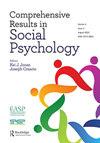Prosocial Propensity Bias in Experimental Research on Helping Behavior: The Proposition of a Discomforting Hypothesis1:
引用次数: 6
Abstract
When researchers fail to control for confounding factors, the causes of behavior can be more apparent than real, even in experimental research. The current study replicates an experiment by Weinstein, Przybylski, and Ryan (2009) with the goal of demonstrating that their main finding could have resulted from differences in people's prosocial propensity. In their research, they found their hypothesized interaction effect: depending on the extent of immersion, participants presented with images of nature were found to be more prosocial in both their actions and in their declarations. Our sample of 175 adults (M age = 29.7 yr., SD = 11.7; 97 men, 78 women) was approached personally, randomly assigned to viewing either urban or nature images, and instructed to immerse themselves in the respective images. Using two formally distinct measures of participants’ prosocial propensity (i.e., before and after the intervention), the hypothesis that individual differences in people's prosocial propensity can bias conclu...助人行为实验研究中的亲社会倾向偏向:一个令人不安的假设的提出
当研究人员无法控制混杂因素时,即使在实验研究中,行为的原因也可能比实际原因更明显。目前的研究重复了Weinstein, Przybylski和Ryan(2009)的实验,目的是证明他们的主要发现可能是由于人们亲社会倾向的差异。在他们的研究中,他们发现了他们假设的互动效应:根据沉浸的程度,看到自然图像的参与者在他们的行为和声明中都更加亲社会。我们的样本是175名成年人(M年龄= 29.7岁,SD = 11.7;97名男性,78名女性)亲自接触,随机分配观看城市或自然图像,并指示他们沉浸在各自的图像中。通过对参与者亲社会倾向的两种形式上不同的测量(即干预前和干预后),人们亲社会倾向的个体差异可能会导致结论偏差的假设。
本文章由计算机程序翻译,如有差异,请以英文原文为准。
求助全文
约1分钟内获得全文
求助全文
来源期刊

Comprehensive Results in Social Psychology
Psychology-Social Psychology
CiteScore
3.40
自引率
0.00%
发文量
7
 求助内容:
求助内容: 应助结果提醒方式:
应助结果提醒方式:


